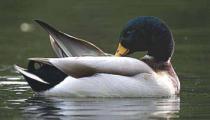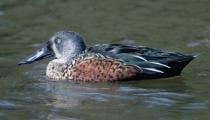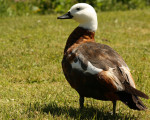There are four key species of duck in New Zealand: Mallard, Grey, Shoveller and Paradise.
There are four key species of duck in New Zealand: Mallard, Grey, Shoveller and Paradise:
Mallard Duck
 The mallard is the most common duck in New Zealand and the Northern Hemisphere. From 1867 repeated attempts were made to acclimatise English game farm stock, but these failed. Then, in the 1930s and 40s, eggs from San Francisco came in wicker baskets onboard flying boats. After that, mallards rapidly spread throughout the country.
The mallard is the most common duck in New Zealand and the Northern Hemisphere. From 1867 repeated attempts were made to acclimatise English game farm stock, but these failed. Then, in the 1930s and 40s, eggs from San Francisco came in wicker baskets onboard flying boats. After that, mallards rapidly spread throughout the country.
Today there are about 4.5 million mallards, so many that they are sometimes a nuisance. The mallard is the mainstay of the duck hunter’s bag.
Mallards are most likely to be found on shallow bodies of fresh water such as wetlands and ponds, on lakes and even flooded fields. They are a medium-to-large dabbling duck that is most recognisable by the male's glossy green head and white collar around the neck. The female is a mottled brown with a brown bill. Both sexes have orange feet and a purple-blue speculum with both sides outlined in white.
Grey Duck
 The native grey duck was once hunters’ main quarry. However, draining wetlands caused loss of habitat, resulting in closed hunting seasons for grey duck.
The native grey duck was once hunters’ main quarry. However, draining wetlands caused loss of habitat, resulting in closed hunting seasons for grey duck.
The newly established and much more adaptable mallard kept the game seasons open, thus maintaining the flow of hunter licence money that helped turn the tide against wetland destruction. Introduced mallards have now taken over from grey duck, comprising 80 percent of New Zealand's dabbling duck population.
In areas where there are still large natural wetlands the grey duck continues to hold it’s own. Although now thinly scattered throughout the mainland, more prominent populations are found in the Northland, Waikato, Gisborne and Westland regions.
A distinguishing feature of the grey duck is a pattern of stripes extending from the bill back onto the head, with a thick dark patch over the top of the head, a thinner brown stripe through the eye, and another fainter line below from the beak opening. Males and females are alike in appearance, and similar to plumage of the female mallard. The grey duck's colouring is darker overall, and the head stripes more pronounced than the female mallard. Grey duck have a white underwing and an iridescent turquoise green speculum on their wing (lower right), whereas the mallard speculum is blue or purple. The blue speculum tends to predominate on hybrids.
Shoveler Duck
 The “spoonie” has comb-like openings in the side of its spoon shaped bill that let it sift fine insect life from the surface of biologically rich wetlands.
The “spoonie” has comb-like openings in the side of its spoon shaped bill that let it sift fine insect life from the surface of biologically rich wetlands.
The shoveler was uncommon last century but there are now around 150,000 in New Zealand. Because of it’s specialised habits, it is unlikely to ever be very common, but birds have moved into wetlands designed for them by Fish & Game NZ.
The male shoveler is New Zealand's most handsome duck, with variegated plumage, blue-grey head with a white vertical stripe between the eye and bill, a striking reddish-brown breast, and blue wings. The female is more plainly embellished with cryptic brown similar to female mallards and grey ducks. This may be nature's way of providing camouflage when she is nesting.
Paradise Duck
 The paradise duck is New Zealand’s only shelduck, which means it is a rather gooselike duck.
The paradise duck is New Zealand’s only shelduck, which means it is a rather gooselike duck.
Paradise ducks or “parries” are another conservation success story. When the country was first settled, paradise duck were rare. The conversion of bush to pasture, and the creation of many stock ponds, (thousands of which were subsidised by hunters’ licence fees), has caused numbers to explode. In fact, special paradise duck hunting seasons are necessary to stop large mobs damaging farm paddocks with their grazing.
Unusually for ducks, the female paradise shelduck is more eye-catching than the male; females have a pure white head and chestnut-coloured body, while males have a dark grey body and black head.
Paradise shelducks are commonly observed flying in pairs or grazing on pasture. They are very vocal birds, with males giving a characteristic 'zonk zonk', while females make a more shrill 'zeek zeek' while flying or as a warning to intruders. They can often be stalked. Resist the temptation to stand up and look as you approach. Instead, pick a tall object and work you way in close remaining down and out of sight. Paddock shooting over simple homemade decoys also works well. Keep out of sight (under a camo net or camouflaged next to a fence line or bushes) and keep close to your decoys. Special parry calls are available on the market.